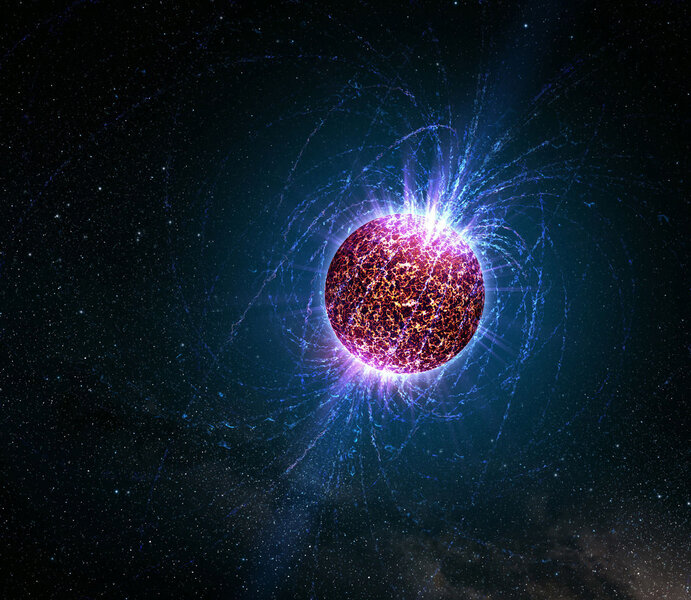Create a free profile to get unlimited access to exclusive videos, sweepstakes, and more!
Binary pulsar puts Einstein to the test… and he passes. Relatively speaking.
Whirling neutron stars make an excellent physics lab.

There are places in the Universe where the laws of physics are pushed to their limits –– where temperatures, densities, energy, motion, and gravity are so extreme they read like an astrophysicist’s fever dream and sound like a science fiction plot device to everyone else.
But then, binary pulsars do actually exist.
And one particular pair of these compact bizarre objects found just a few years ago has proven to be a cosmic playground for a team of astronomers. They’ve made observations so precise they’ve been able to tease out details of how the binary warps the very fabric of space itself, putting Einstein’s Theory of Relativity to one of its most stringent tests ever undertaken.
Surprise: It passes, even while a couple of contender theories do not.
OK, backing up a bit: Pulsars are neutron stars, the ridiculously dense cores of massive stars after they go supernova. The outer layers of a massive star explode away, but the core collapses, compressed down from an object as big as the Sun to something literally a couple of dozen kilometers across.
These objects can be more massive than the Sun, but they’re so small their density skyrockets. A single cubic centimeter of neutron star material — the size of a six-sided die — can weigh 100 million tons. So yeah: dense.
When first formed, they spin rapidly and can have extremely powerful magnetic fields. Any material nearby is swept up into these fields, accelerated by them and the mind-crushingly strong gravity of the neutron star itself, and channeled down to the magnetic poles on the star’s surface. The material slams into it at a respectable fraction of the speed of light, generating huge amounts of energy, focused into beams like a lighthouse. As the stars spin, these beams sweep across space, and we see them from Earth as blips of light, pulses with fantastically regular periodicity. Hence pulsars.
In 2003 astronomers discovered a pair of pulsars orbiting each other. Dubbed PSR J0737–3039A/B, the binary is located about 2,400 light years away in the constellation of Puppis. They orbit each other in a near-circle about 430,000 kilometers apart — a little bit more than the distance of the Moon from the Earth — but their over-the-top fierce gravity slings each around at a staggering 1 million kilometers per hour, completing a single orbit every 2.45 hours.
One of the two stars (pulsar A) spins once every 23 milliseconds — over 40 times per second! — making it what we call a millisecond pulsar, and the other (pulsar B) spins once every 2.8 seconds. Both have a mass a little over the Sun’s.
Put all this together and you have a phenomenal laboratory to test relativity.
A team of astronomers has used seven different radio astronomy observatories to watch this system for over 16 years, timing with exquisite precision exactly when the pulses from the two stars reach Earth. There are some obvious effects that can affect when the pulses arrive; for example, if pulsar A is on the far side of its orbit, it takes longer for the pulses to reach us due to the added distance, while the pulses from B arrive before those of A.
But there’s much, much more. General Relativity is a set of rules for how things behave in extreme environments of high velocity and/or intense gravity. One effect of this is time dilation: The closer you are to a source of gravity the slower your time flows relative to someone far away. The astronomers see this in the binary: When the pulses from pulsar A, say, pass by pulsar B on their way to Earth, time for them slows down, so there’s a slight delay in when we receive them, called a Shapiro delay.
Another delay occurs because of the orbital motions of the two pulsars around each other. They move so rapidly that there is an effect called relativistic beaming, which changes the angle of the light emitted ever so slightly. This too, small an effect as it is, is seen in the pulsars’ signal.
One of my favorite relativistic effects is due to the way the gravity of the pulsars warps spacetime, bending it like a bowling ball sitting on a bed. As the pulsars move through each other's gravity, the orientation of their orbit changes, slowly turning in space. This effect was first seen in Mercury’s orbit around the Sun, and in the early 20th century was hailed as strong evidence of the correctness of Einstein’s Relativity theory. It’s been seen many times since, including in a star that orbits our galaxy’s central black hole, and is seen in the binary pulsar as well.
There’s still so much more. As the stars spin, they drag spacetime around them like a ball spinning in honey. This is called frame dragging, or more formally the Lense-Thirring effect, and it also measurably changes the pulses received from the stars.
As the stars orbit each other they emit gravitational waves, ripples in the fabric of spacetime, and this steals energy from them, shrinking their orbital size. That can’t be seen directly, but as they get closer to each other they orbit more rapidly, and this changes the period of their orbit. That too has been seen in the data.
Several other subtle effects were detected as well. Clearly, this system provides some of the most stringent tests of relativity ever seen, and it passes them all.
Still, there are other theories of gravity, ones that hope to supersede relativity. We know that there are some behaviors that relativity doesn’t cover, especially dealing with quantum mechanics, and so new ideas come along which potentially could modify it. These theories make predictions too, and the astronomers tested them against what they see in the binary pulsar system… and find them wanting. While relativity covers their behavior extremely well, these other two ideas don’t.
That’s fine! Not every idea works out, and we have to test them. Most fail. We know there’s more out there than relativity and quantum theories, so we have to keep trying to figure out what it is, and we have to test these ideas against the actual Universe.
That’s what makes systems like J0737–3039A/B so important. They allow us to take the pulse of the Universe, so to speak, and use that information to not only develop new ideas but to test them rigorously.
That’s the point of science: To know better the truth. We don’t want to fool ourselves; we want to know what’s really going on out there. The rules of the Universe exist, and they are both subtle and gross. By studying the cosmos carefully, we can tease these rules out.





























